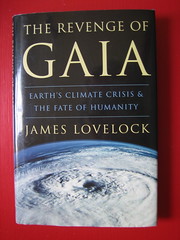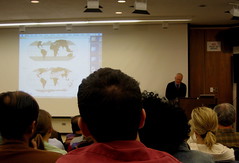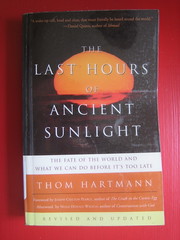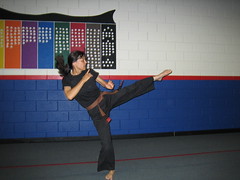Gaia's Physician
In Japan, scientists enjoy a celebrity status much like a sports hero or rock star. Their achievements evoke national pride, thus their pictures grace billboards and t-shirts and their appearances at public venues cause a stir. Scientists in the West have been so summarily dismissed for their inconvenient truths that I felt compelled to impart a little celebrity idolatry to the British scientist, James Lovelock during his recent book tour.
Catherine had already bought a copy of his latest book "The Revenge of Gaia". This was the man who came up with the Gaia hypothesis, which states, in short, that the earth is a living, self-regulating organism and not a dead rock upon which life clings. This view of the earth was considered controversial in the scientific world, given its anthropomorphic flavor.
James Lovelock is now rattling the cages of environmentalists by coming out in favor of nuclear power. His opinion is not easily discounted, because he was the man who convinced the scientific community that the ozone hole was indeed a threat and that governments should ban ozone-destroying CFCs.
In a recent article on the issues of global warming, Lovelock stated that he would happily offer his own backyard for the storage of nuclear waste if that's what it would take to convince the public to support the building of nuclear power plants, so adamantly did he feel that the waste was of little consequence next to the dire need for emission free power. Nor would it take up much space. Though I agreed with him that the situation was dire, I was far from convinced that nuclear power was as benign as he claimed. I was curious to see how he would present his case.
We made an outing of it with our friend Dave. Our quest led us to a packed auditorium in the bowels of Stanford University. The 87-year-old scientist, trained in chemistry, cut a mild mannered figure as he calmly read his paper on the impending desertification of the planet. This was not the first time the planet would experience a devastating global warming, he told us. 55 million years ago such an occurrence did happen when up to 3.0 terratons of carbon were released into the atmosphere due to a geological event that is still under debate, but might have been prompted by a subterranean volcano. It took another 100,000 years for the earth to recover its lush green coolness.
There is something about history repeating itself that seems curiously inevitable. If it happened before, it can certainly happen again and according to Lovelock's forecast, it will take us about 40 years to add enough carbon dioxide to the atmosphere to cause the ice on Greenland to melt, algae in the too warm ocean to stop growing and the tropical forests to dehydrate. All of this "positive feedback" would quickly create a planet so barren of life that only the most northern and most southern parts would be habitable.
To aid us in visualizing this predicament a series of three maps were projected onto the screen. One showed the earth as it is now. One of it at -5C cooler than today when there were no deserts, and one at 5C warmer than it is now where virtually all of the continents are desert save for the very tip of south America and a strip that spanned northern Canada, all of England, northern Europe, Russia and China. We all gazed at this strip of habitable earth and wondered where we might buy viable real estate to see us through the next 100,000 years.
It stretches the mind to accept such a fate and not all those present were ready to. Despite the intelligent questions of many young people in the audience, there was one middle-aged man who challenged the evening's presentation for being one sided. Where was the other perspective he wanted to know? The one that said this wasn't happening. James Lovelock grasped the man's desire for a TV style debate and pointed out that this was not a matter of debating different interpretations such as lawyers would do in a court of law. This is nature's law unfolding in response to scientifically observed phenomena. The discussion was now about how soon and how fast.
Someone else asked if he had seen "An Inconvenient Truth". He had not, but he had reviewed the book of the movie and had found the science to be accurate. He just felt that Al Gore hadn't gone far enough. No one thought to ask how far he should have gone. And if Gore had gone further, I thought, he would have lost half his audience. There is a limit to how much we can take in at one sitting.
In the days following James Lovelock's presentation I did not want to think much about his forecast, but I felt changed in my perceptions of global warming. It is useful to go to the extreme end of an issue, if only to confirm that the more moderate perspectives were indeed viable. He had not discussed nuclear power in his lecture, so I decided to read his book.
In it he writes extensively of our fear of all things nuclear, our fear of cancer and our overreaction to the use of synthetic fertilizers and pesticides. The significant causes of the devastation of Gaia, as he calls the earth, are combustion, cattle and chainsaws or the burning of fossil fuels, too much manure silting up waterways and deforestation.
To see the world as James Lovelock does, it is helpful to evoke the photograph of earth from space and imagine sitting at the bedside of our ailing planet as she undergoes this fever we call global warming. Looking at the earth in all its beautiful blueness we cannot see all the humans on it anymore than we can see cells in a human being. And in treating this planetary fever, we must consider the earth as a whole and not necessarily the individual cells.
It is from this perspective that Lovelock justifies nuclear power. For nuclear power is not harmful to the earth. This was stunning news. I had thought that nuclear waste would devastate all living things, but apparently this was just our human centric projection. Plant life seems to thrive where nuclear waste has been leaked. Here he shows a picture of Par Pond, a waste repository outside of the Savannah River Nuclear Facility in the US and it is indeed lush with growth. As for wildlife, their lives might be shortened by a week or two, but it was a small price to pay for keeping the earth itself alive.
He did not mention how the animals would die, but he did attribute the main cause of cancer to be a by-product of our breathing of oxygen. Now I was really caught off guard. This I had never heard, but apparently our own combustion process, when the oxygen we breathe combines with the food we eat, creates pollution. If the cell doesn't manage to neutralize this pollution, as once in a while it doesn't, then we have a renegade cell that reproduces unchecked. So the 30 percent of humans who will die of cancer are not all being poisoned by our industrial toxins, but are reacting to oxygen, something we can't live without.
I felt as though all that I had believed about the dangers of toxins and radiation had been largely propagated by media hype and I had been duped. Yet if I started to talk about how nuclear power was not nearly as dangerous as perceived, I sounded like a Republican.
And yes nuclear radiation, whether man made or naturally occurring, can cause cancer, but not enough to add significantly to the 30 percent cited above, he claimed. A hydroelectric-generating damn that burst would devastate many more lives, given that so many would be killed instantly, than did Chernobyl failing, in which only 75 people died (those who directly fought the fire or cleaned up afterwards.) Speculation of deaths related to exposure to the radiation was just that - speculation. Considering that all of us alive have been exposed and continue to be exposed, worldwide, to radiation from the underground testing of nuclear bombs, what's a little more radiation?
We are having this conversation because of civilization's need for electricity. And on this topic Lovelock has more news. Wind power, that silver bullet of the environmental movement, could quickly be made obsolete by the changing climate and the redirection of the wind itself. We could use our remaining fossil fuel to build windmills and litter the landscape with this giant hardware, only to find that the direction of the wind has changed or is non-existent. We would be caught like sailors in the doldrums. And solar was too expensive, he stated, but I will not concede him that claim, having installed solar panels on my own house.
James Lovelock's big picture of the planet leads him to prescribe big picture solutions, thus his plea for nuclear power. And though he has changed my mind about the dangers of nuclear power (when used properly and not sabotaged by terrorists or nations wishing to drop bombs) I am not willing to embrace nuclear power because I am not for centralized power in the first place.
Centralized anything does not inspire my imagination. I would rather we invented hand crank, battery operated toasters and rethink civilization, not as something that needed a steady feeding of electricity, but as something that could remake itself in an imaginative Leonardo De Vinci sort of way. James Lovelock claims that we do not have time. The centralized civilization that we are will continue to pollute carbon dioxide from fossil fuel burning plants unless given a viable emission free substitute. He has described the outcome of our continuing to add emissions to the atmosphere - a planetary die off of 80% and a two-thirds uninhabitable planet.
As a scientist, James Lovelock doesn't go in for the cultural or lifestyle change that other solution oriented authors suggest we undergo in order to solve this planetary crisis, but it is useful to look through the lens of his perspective in order to see the hard reality of what we're really up against and how our idealism and fears get in the way.
This living in the shadow of planetary disaster is, to me, the metaphysical test of our time. If we do nothing, disaster will most certainly befall us. And it may, anyway, even if we do, but the process of facing it squarely will enlighten us. Or as James Lovelock put it in his interview with Terry Gros, "I am optimistic about the 20% that will remain."







